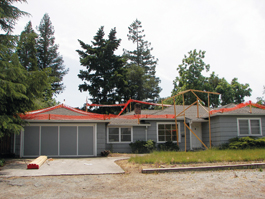home | metro santa cruz index | news | santa cruz | news article

Photograph by Traci Hukill
Once Upon A Time There Was A Bungalow: Story poles, used by some cities to show the size of new projects or additions, aren't used in Santa Cruz. Beach Hill resident Don Webber wants them implemented for the La Bahia hotel project.
Model Development
The La Bahia hotel project, proposed for Santa Cruz's Beach Street, is too big to show how big it is. Does that mean it's too big?
By Will Mosher
Don Webber is walking to his beachside home. The breeze carries the sound of screaming tourists from the Boardwalk to where his house overlooks the La Bahia apartment complex. It's a beautiful day in Santa Cruz, but Webber is ill at ease. As he stacks imaginary shapes on top of each other in the visual field where a new hotel is proposed, he begins talking about how much easier it would be for people to understand the scope of the development if they could just see it. Webber thinks story poles--poles wrapped with fluorescent orange webbing that show the height of a planned building or addition--would serve the public interest by letting them know what proposed developments look like before they're built.
"For people who don't go to the meetings, who don't look at the computer graphics and who don't really know where it is," Webber says, story poles can fill in missing information. Webber thinks his neighbors have a vague idea that the hotel proposed for the La Bahia site is a modest structure located somewhere in Beach Flats.
"But in fact, it's a seven-story structure across from the homes on First Street," Webber says. "Now the story poles would make that abundantly clear to a much, much larger segment of the community."
His idea to erect poles for the project was declined in writing by the developer, Barry Swenson Builder, and by the Santa Cruz Planning Department.
"It's been my experience that these story poles are used primarily for buildings such as single-family residences which are 30 feet in height," wrote Eric Marlatt, principal planner with the city of Santa Cruz, in response to Webber's request. "In contrast, if this technique were used for the La Bahia project, some of the story poles would reach heights of 65 feet. Poles reaching this height in this location would pose liability hazards, not to mention likely targets of vandalism."
Webber interprets the polite argot of the Planning Department in this letter to mean that a representation of the size of the building is, paradoxically, too large to build.
Though story poles are required in some jurisdictions along the coast where communities share intense competition for views and space--including Monterey, Seaside and Los Gatos--there isn't any legislation on the books in Santa Cruz that requires the construction of story poles over beachfront development, according to Marlatt. Planning officials say no one has ever campaigned for them or suggested their requirement in Santa Cruz before.
In Monterey, where infill development may intrude on coveted ocean views, story poles on new developments or second-story additions are required to stand for 10 days before a public meeting, allowing neighbors to assess the impact and take action if they wish. Forrest Ebbs, a planner with the city of Monterey, calls it a "view-sharing policy."
"The neighbors' concerns do not automatically kill a project," he wrote in an email, "but we must offer them the opportunity to voice their concerns and notify them of the project in the first place. In the past, people were not even aware until the project was under construction."
Webber owns a home whose rare view of the ocean would be blocked by the development, though he insists that he does not oppose the hotel's construction. He claims he just wants story poles for the 125-room structure.
Webber believes that the true nature of the construction is being obfuscated by the Planning Department, which gives the neighbors the responsibility of educating themselves about the size of the proposed development. He says the tools used by the department, which consist of diagrams and computer models, aren't public enough. He adds that it's cynical to suggest that if residents were really interested in the La Bahia, then they would make more of an effort to see the models and attend the meetings.
"It's kind of a full-scale model," Webber says, pointing out the outline story poles would make if they were installed on the site of the future hotel. "The city tends to rely on computer graphics and PowerPoint graphics. And they're fine, but there's something visceral about walking up to it and seeing it. I told one of the councilmembers that it's like watching Jurassic Park on a cell phone. You just don't get the effect."
The Planning Commission receives public comment on the proposed development of the La Bahia hotel on Thursday, May 15, at 7pm in the City Council Chambers, 809 Center St., Santa Cruz.
Send a letter to the editor about this story.
|
|
|
|
|
|